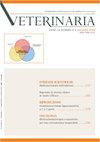ARTERIAL AND VENOUS VASCULARIZATION OF THE LUNG IN AMERICAN MINK (NEOVISON VISON)
Q4 Veterinary
引用次数: 0
Abstract
This paper presents a comprehensive anatomic overview of normal pulmonary vascularization in an American mink (Neovison vison), with emphasis on venous and arterial peculiarities as regards its course and potential disruptions. The study is designed as macro-morphological and vascular network analysis of lungs of fifteen minks of different age and gender. Dissection is conducted along with injection corrosion method in order to clearly visualize the vascular topology, bronchial tree, arterial and venous trees, and their interconnections. The specimens exhibit consistence in the arterial branching pattern with negligible range of alterations. It was noticed that upon leaving the right ventricle of heart, pulmonary trunk divides ventrally from the site of tracheal bifurcation. The divisions were identified as left and right pulmonary arteries, which then ramified in the left and right lung, respectively. Left a. pulmonalis further divides into two major branches ramus lobi cranialis and ramus lobi caudalis, while the right a. pulmonalis gives five major branches for lobes in the right lung. Total of five pulmonary veins leave pulmonary lobes and enter left atrium of the heart. Mink has a distinct niche in biomedical research, proving as a suitable model to enhance the understandings of the various diseases. Gained insights are valuable as reference values for examination of the vasculature in other Mustelidae species, recognition of potential deviations and vascular remodeling due to respiratory diseases.美洲水貂肺动脉和静脉血管的形成(neovison vision)
本文介绍了美国水貂正常肺血管形成的全面解剖学概述(Neovison vision),重点介绍了其过程和潜在中断的静脉和动脉特性。本研究对15只不同年龄和性别的水貂肺进行了宏观形态学和血管网络分析。采用注射腐蚀法进行解剖,使血管拓扑结构、支气管树、动脉树、静脉树及其相互关系清晰可见。标本显示动脉分支模式的一致性,变化范围可以忽略不计。我们注意到,在离开右心室后,肺动脉干从气管分叉处向腹侧分开。这些分支被确定为左肺动脉和右肺动脉,然后分别在左肺和右肺分支。左侧肺支又分为两大分支:额叶支和尾叶支,右侧肺支分为右肺叶五大分支。共有五条肺静脉离开肺叶,进入左心房。水貂在生物医学研究中有着独特的定位,被证明是一种合适的模型,可以增强对各种疾病的理解。获得的见解对其他鼬科物种的血管系统检查,识别呼吸系统疾病引起的潜在偏差和血管重塑具有重要的参考价值。
本文章由计算机程序翻译,如有差异,请以英文原文为准。
求助全文
约1分钟内获得全文
求助全文
来源期刊

Veterinaria
农林科学-兽医学
CiteScore
0.10
自引率
0.00%
发文量
21
审稿时长
>12 weeks
期刊介绍:
VETERINARIA is the official scientific journal of the Italian Companion Animal Veterinary Association (SCIVAC) and is published bimonthly by Edizioni Veterinarie (E.V.). Its aim is to promote the spread and development of new ideas and techniques in the field of clinical and veterinary practices, with the ultimate goal of improving and promoting the continuing education of veterinary practicioners. VETERINARIA publishes literature reviews, original articles, diagnostic corners and clinical cases on different topics related to medicine and surgery of the dog, cat and of other companion animals, as well as short communications from congresses.
 求助内容:
求助内容: 应助结果提醒方式:
应助结果提醒方式:


